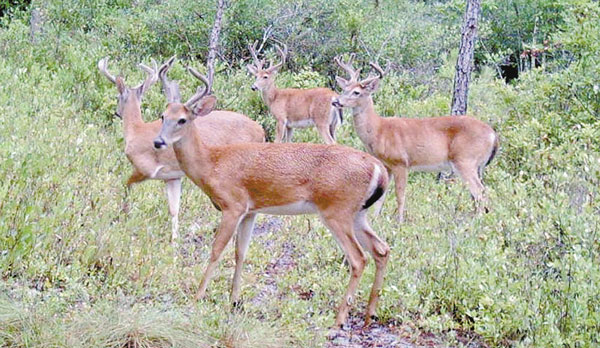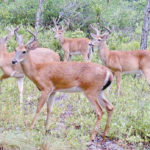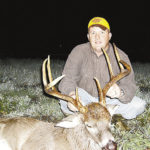
Any seasoned hunter understands the investments needed to grow quality deer and bumper populations of ducks and quail on their hunting lands. Premium wildlife populations require special attention steered towards the habitat and the animals themselves. Adequate nutrition and controlled harvests are critical components, but every piece of land has its own set of hurdles, and every landowner or land manager has their limited budget. Even on the best sites, it takes years to perfect management techniques on the land and within animal harvests. Outdoorsmen and land managers must develop strategies for providing adequate nutrition and protection for their wildlife through continual habitat-management techniques for existing natural foods and cultivated crops. Every month can offer tasks and techniques to improve native habitat for its furred and feathered users.
Jason Kiker, the owner/operator of Buchanan Shoals Sportsman’s Preserve, elects continual or sustainable management for all of its wildlife resources.
“Annual maintenance of timber and food plots continues to provide excellent habitat for our whitetail deer, turkey, and wild quail,” Kiker said. “Our dedication to wildlife habitat-management includes prescribe burning, year-round supplemental feeders and herbicide applications to control unwanted vegetation and increase natural food sources.”
Buchanan Shoals (www.buchananshoals.com) is a private 5,300-acre wildlife paradise located along the North Carolina/South Carolina state line on the Pee Dee River. just west of Wadesboro, N.C., but with acreage in both states. Kiker intensively manages the property throughout the year, providing optimal nutrition, growing quality wildlife, and creating premier hunting opportunities for his membership. In addition to promoting native vegetation through prescribed burning and timber harvesting, Kiker maintains over 60 acres of food plots, including clovers, Japanese millet, sorghum, partridge pea, rape, lab-lab, brassicas, as well as a mixture of many other plot seeds to fulfill their supplemental food program throughout the property.
Heath Rayfield, the preserve manager, plants and maintains a variety of foods for the wildlife. “Anything that will grow around here beneficial to the wildlife, we plant,” Rayfield said. “It takes a year-round approach to keep our plots lush and likable to our wildlife.”
Rayfield is a firm believer in the no-till drill method of planting, in combination with a heavy herbicide treatment before planting. “The soil is full of dormant weed seeds, and plowing engages these seeds. Avoiding too much soil disturbance is key,” he said.
Over the past decade, Kiker and Rayfield have learned what works for them and what doesn’t. They keep protein-rich foods available throughout the year to keep wildlife happy and healthly. Even in mid-summer, Rayfield keeps the tractor running almost every day, whether replanting temporary food plots or conducting periodic mowing. As a general rule, spring planting is limited to plantings just before rains, but unexpected dry weather can destroy a plot, and temporary replanting may be necessary to maintain productive food plots throughout the preserve. Rayfield will plant peas and milo in these areas.
In addition to habitat, the harvest of game animals must be controlled and managed. Controlling harvests is equally important as providing adequate nutrition. Even the best tracts, with premium food plots and supplemental nutrition, need harvest controls to grow mature animals. Plans should always begin with primary objectives: the number of does and the number and size of bucks to be harvested. Plans should change year to year until optimal results are maintained.
For starters, deer have relatively small home ranges in the Carolinas, usually one square mile — 640 acres. However, deer will migrate throughout the year to take advantage of rich food sources, water, to evade continual disturbance and to locate mates. Deer do not recognize property boundaries. Each deer’s home range will be different, and a property will have a mixture of full-time residents and many others with only a portion of their home range located within the club’s boundaries. Since most clubs are less than 1,000 acres, harvest plans on small properties should be less intensive than on larger properties where control is more achievable.
The majority of most harvest restrictions are on the number of does and antler size. Doe harvests are intended to control the overall population, and antler restrictions are developed to restrict buck harvests to only mature animals. While antler restrictions has its merits, some of the genetically-superior bucks end up on the skinning rack at an early age, several years before reaching their full potential. Bucks can reach their genetic potential on any property if allowed to celebrate their fourth or fifth birthdays. While antler restrictions help smaller deer and genetically-inferior bucks live another year, limiting the total buck harvest to a small number will allow many more male deer to reach maturity. In fact, buck age-classes are in the shape of a pyramid, with many 18-month-old bucks around and just a few bucks living three to five years of age. The fewer 3- and 4-year-old bucks harvested each year will make the next season extremely promising.
Ever wonder why hunters continue to pass up 1½-year- old bucks each year, but only see a few 2½-year-old deer the next year? As the deer population increases, the home ranges of does begin to overlap, and does will kick out young bucks, forcing them to disperse. Normally, this takes place within a 2-week period in April, just before does drop their fawns. The young bucks primarily move to prevent inbreeding and are more apt to disperse when deer populations are high.
Typically, young bucks will disperse anywhere from two to five miles. However, a telemetry study conducted on Maryland’s Eastern Shore by N.C. State University documented several bucks traveling between 50 and 70 miles during the spring dispersal. Although young-buck harvests is not preferred, harvesting yearlings has less effect on the trophy potential than eliminating the 2½- and 3½-year-old bucks. These slightly older bucks are residents and should be protected so they can reach their full potential. They also participate in the majority of the breeding, especially when doe populations are excessive.
Everybody wants to kill big bucks, but few want to participate in doe harvests. While bucks need to be killed each year, doe harvests are a necessity to control the population. Hunters should not just go on a doe-killing spree each year because they think they are over populated. Does should be an important part of every harvesting plan, but the level of harvest should be monitored annually to determine if more or fewer should be harvested. Fortunately, deer season falls within the mating season, and bucks will be seeking out every doe until they are all mated. If hunters overharvest does, bucks will leave the property in search of mates on adjacent lands, to be taken by members of neighboring clubs.
Many hunters are restricted to hunting small properties only a few hundred acres in size; this is the reality for many hunters across the Carolinas. Developing harvesting plans on these properties can be challenging. Again, deer have relatively small home ranges, but they will migrate to other lands outside of their home ranges. However, this does not mean harvest plans cannot be implemented on smaller properties. Cooperative agreements must be obtained from neighboring landowners to control harvests and to manage the population as a whole. In fact, wildlife management and big-game harvesting plans will always be more effective on a large scale. Everybody has property boundaries, and animals continually move across property boundaries. As long as each landowner’s objectives are similar, hunters with small or large properties will always benefit from cooperative agreements with similar harvesting restrictions and prescriptions.






Be the first to comment